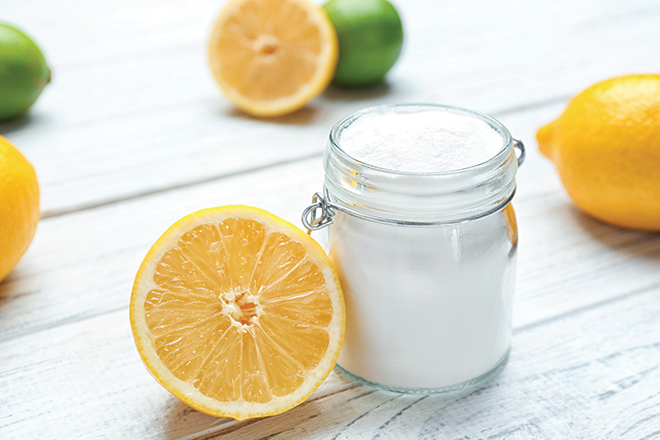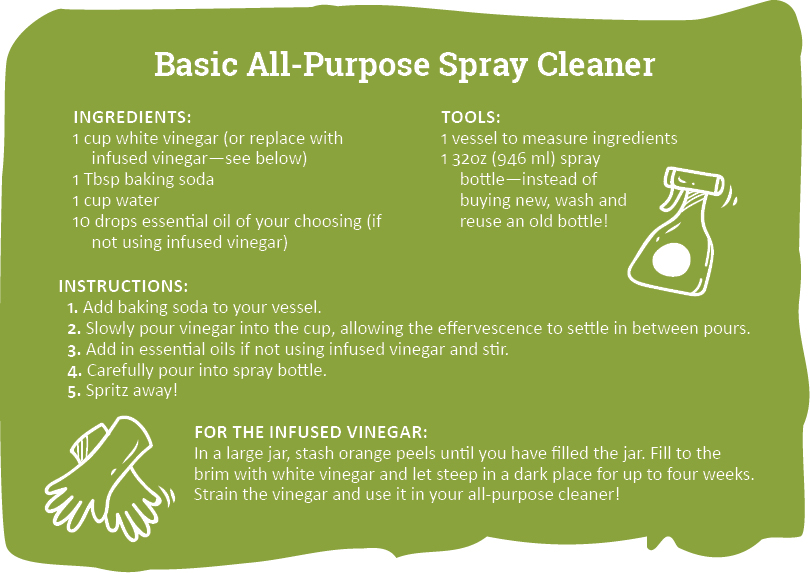By Ryan Elizabeth Cope –
Here in British Columbia, winter extends from mid-November to late-April, depending on the region. In some places, the snow never stays very long while in other far-flung regions the icy chill refuses to let go until well past May Day. Over the winter, we’ve retreated to our warm, indoor spaces and while all this cosiness has been a blessing, it has created a bit of a dust-bunny situation in our houses. As the days get longer and the Earth begins to thaw, let us finally stretch our legs, roll up our sleeves, and give our dwellings (and bodies!) a nice, spring-cleaning.

This year, however, take a good, hard look at your cleaning bucket. Certain lemon-scented cleaners and that miracle streak-free blue liquid are popular options for sweeping the dust from countertops and making glass windows shine, streak-free. But as we become more aware of all the issues currently plaguing our environment, we must also become aware of the products potentially adding to the situation.
Have you ever looked at your bottle of spray cleaner and wondered why there are no ingredients listed on the bottle? Why don’t companies list their ingredients? In short: because they are not required to. If they do, it is usually only the active ingredient. In some instances, companies will list their ingredients, but will hide behind misleading and generic terminology, like “fragrance.”
Fragrance, as it turns out, is not regulated by any government agency and often comprises hundreds of chemicals combined to bring us the popular scents we’ve come to know and love in our household cleaners. Unfortunately for consumers, these chemical concoctions remain a mystery, shrouded under a veil of “proprietary” information, classified as trade secrets and hidden from public view. Because they remain hidden and because we are exposed to so many chemicals on a daily basis, there is almost no way of knowing what exactly is in our products, and how exactly it is impacting our health and the health of our families.
A recent documentary called Stink! shines a light on the dirty side of chemical labelling. The film points out that as consumers we make a lot of assumptions when it comes to the products we buy. We assume that these products are safe; well, “that is a fundamentally inaccurate assumption,” notes Jeffrey Hollender in the film. There is currently no law on the books stating that household cleaners need to include a full list of their ingredients.
Because we have no knowledge of what comes out of our spray nozzles, we have no way of preventing ourselves from over-exposure to chemicals that may create chronic health risks. Our health (and our air quality) are areas of our lives that should never be compromised.
The ultimate solution? Do It Yourself. The only way to know with absolute certainty what you’re spraying on your kitchen and bathroom surfaces is to make it. DIY household cleaners have the benefit of being simple to make, often with materials you already have in your cupboards (and, they’re cheap!). Indeed, a quick Google search for “DIY household cleaner” yields over 45 million results, which is a sign that there is a sea of change happening with respect to the way we keep things clean.
Sometimes, though, 45 million hits on Google can have the exact opposite effect: too many choices, overwhelm, and we’ve succumbed to a store-bought spray-cleaner. To save you time searching, the following recipe is an easy and inexpensive all-purpose spray cleaner. Cleaning can be a joy, and with the right products it can bring your home brightness, shine, and better air quality. Smells like spring to me!

Ryan Elizabeth Cope is a Kelowna, BC-based advocate for plastic-less, healthful living. She blogs at Seven in the Ocean (sevenintheocean.com) where she marries her love of food with her disdain for plastic-wrapped garbage.

